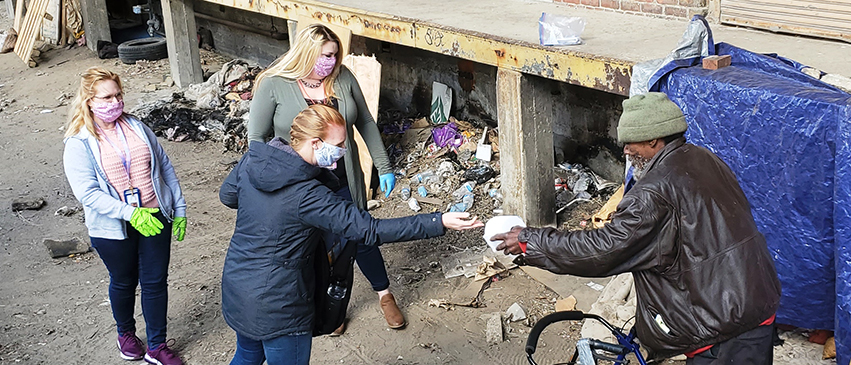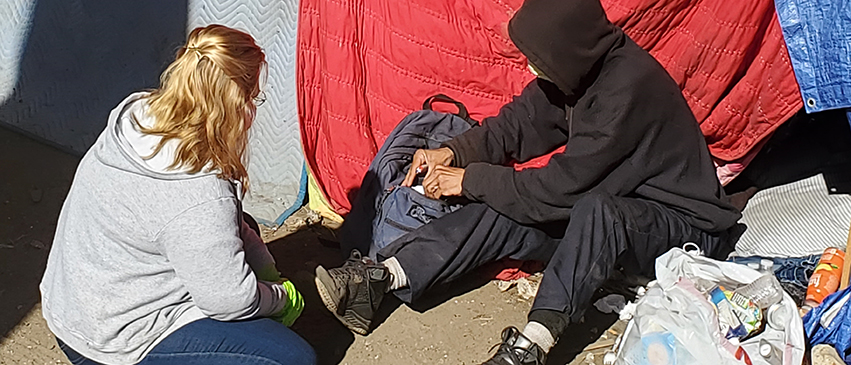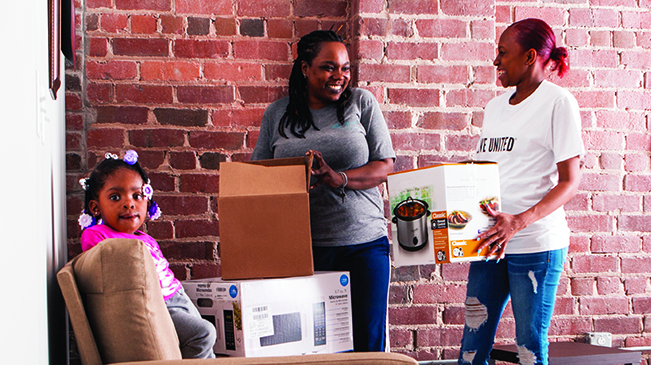Home for All: Addressing Homelessness Together

For many of us, the concept of homelessness is far removed from our personal experience. We often take for granted the possibilities afforded to us simply because we have a place of refuge, a place to share with family and friends, a hot shower, a warm meal. We underestimate the inextricable link between having a place to call home and being able to take care of our needs. In light of the ever-evolving landscape created by COVID-19, many of us struggled with the challenge of staying at home. But for some, the privilege of having a safe location to shelter in place and focus on social distancing was not within reach.
For a whole host of reasons, most of us typically do not feel empowered to help when we pass an individual experiencing homelessness on the street. One of the first steps we can all take is to recognize the person first and understand that they are going through an extremely challenging circumstance. Once we start seeing the person and exercising empathy for their situation, it can change our knee-jerk response, which is often built on assumptions.
Homelessness can occur for a myriad of reasons: situational circumstances such as losing a job or a medical emergency, fleeing domestic violence, struggling with addictions or mental health challenges, managing disabilities or attempting to re-enter society after incarceration. No two stories are the same. Last year, nearly 1,600 unique individuals in our community experienced homelessness. The good news is that there is a tapestry of agencies woven together to ensure homelessness is rare, brief and a one-time occurrence by promoting the full potential of individuals and families.
A Systemic Approach
The collective impact model became all the rage several years back, and for good reason. It pulls in stakeholders from different sectors to work together to solve a defined problem. We often operate in silos, not understanding the impact of our work on other organizations or sectors. And while I would hesitate to say that the federal government is always excellent at crafting policy, the model the Department of Housing and Urban Development (HUD) instituted in 1994 for communities to access homelessness funding was ahead of its time. HUD required every part of the country to be covered by a local Continuum of Care: a strategic planning body that works to address homelessness with a systemic approach.
It has been an evolving process since the ‘90s. HUD has worked to mature the sophistication of Continuums by leveraging the ever-powerful tool of funding. Meanwhile, the work has grown beyond the confines of housing into the realm of criminal justice, healthcare, education and more. Locally, we have a committed base of nearly 40 organizations working to address the needs of those experiencing homelessness. Collectively, we are called Home for All Continuum of Care, with an emphasis on the foundational assumption that all people deserve a place to call home. Could you imagine attempting to land a job, flee domestic violence or address addiction issues when you aren’t sure where you will lay your head at night?

Collaboration at Its Best
Our local providers are excellent at the work they do. But as with all grant-funded efforts, resources are limited. In order to ensure we are addressing the most critical issues, individuals and families who present as homeless work through a prioritization process to access services. Those in most dire need are placed at the top of the list. Federal funding that supports these services are funneled through Home for All.
Each funded provider pulls from the same list when identifying placements for units, utilizing a shared data management platform that helps to inform system-level decision-making. It is a highly strategic way to prioritize what services we offer and who will receive them. These resources range from homeless prevention and emergency shelter to short- and long-term supportive housing placements. Within each of these pathways are resources working toward the goal that homelessness is brief and does not happen again.
The collaborative efforts of the Continuum have been on full display during the COVID-19 crisis as it works to ensure the safety of our most vulnerable. Community partners leaned in to plan how to de-concentrate our largest shelters and provide adequate isolation space. Agencies stepped up to fill the gaps created by the closure of many businesses and organizations deemed “non-essential,” but which serve as lifelines for those experiencing homelessness.
Our community’s strengths have been evident. We are compassionate and willing to do the hard work. But there is still much work to do because ending homelessness in our community doesn’t have to be an inspirational tagline—it could be a reality.

How Do We End Homelessness?
Ending homelessness does not mean that situational drivers of homelessness cease to exist. It means our community has the capacity and wherewithal to ensure that any individual or family who needs support in regaining safe, affordable housing has access to it. Access is key, as the affordable housing crisis impacts every part of our nation. While the situation is more apparent and dire in larger cities like Los Angeles, the real impacts of housing insecurity exist right in our own backyard.
When considering the larger picture and the potential for homelessness (including couch-surfing and doubled-up families), we must be thoughtful about affordable housing—housing that is affordable for those with a median household income or less—and the positive impacts that safe, quality and affordable housing has on our community’s overall health. The “not in my backyard” mentality must become a thing of the past as we grow in understanding the connected nature of our collective success.
What challenging times we are living in right now! And yet, the work I see happening across our community to meet the needs of the most vulnerable inspires me on a daily basis. The critical need to support individuals experiencing homelessness has only grown over the past few weeks. We cannot end homelessness without the work our partners are conducting to ensure this support system is in place as we navigate this crisis year-round. PM
Kate Green is executive director of Home for All Continuum of Care, a partnership of over 50 cross-sector organizations aligning to end homelessness through support of individuals and families seeking permanent, safe and affordable housing.
- Log in to post comments

